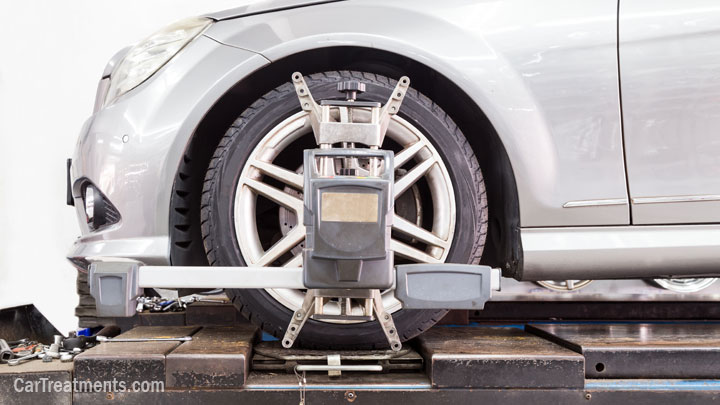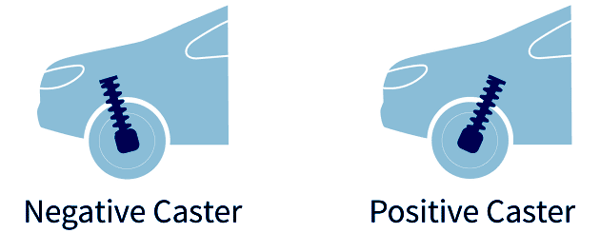What is Caster? (Negative vs Positive Caster Effects)
Ever wondered what gives your steering that natural weight and straight-line stability? It’s likely your vehicle’s caster angle. Caster plays a key role in steering and handling, yet its effects aren’t always well understood.
In this article, we’ll explain (in layman’s terms) what caster is, how it impacts steering, and the differences between positive and negative caster.

What is Caster On a Car?
A vehicle’s suspension geometry has three common measurements, which can often be adjusted, called caster, camber, and toe. Caster is measured on the steering wheels (i.e the front wheels) as an angle which evaluates the forward or backward tilt of the steering axis when viewing the car from the side.
This axis connects the lower pivot point (often the lower ball joint) with the upper pivot point (often the upper ball joint), and forms an angle with the vertical line going through the lower pivot point.
Positive caster is when the vehicle’s wheel (and lower pivot point) is in front of the upper pivot point. Negative caster has a lower pivot point behind the upper pivot point, and zero caster means the steering axis is perpendicular to the ground.

Caster affects the steering ease and the stability of the vehicle in a straight line. Modern cars use positive caster in order to resist unintentional turning of the vehicle, or wandering/straying from the intended path, when traveling straight at speed.
A car that pulls to one side when traveling in a straight line may have negative caster. Cars with power steering should have positive caster, so this vehicle should have its suspension checked and realigned by a mechanic.
Caster vs Camber

Camber is another angular measurement in the suspension, measuring a different axis of tilt than caster. Camber refers to how much the wheels “lean” in towards the car or out away from the car when looking straight on at the front of the car, into the grill. This affects the area of the tire contacting the ground during various driving maneuvers.
You may have heard of cars that are “slammed” or have “stance.” This slang terminology refers to significant negative camber, where the tops of the wheels are pointed towards the car body and the bottoms of the wheels pointed away from the car body relative to the vertical line that goes through the center of wheels with no camber.
Negative camber increases grip while turning/cornering, but decreases grip on acceleration or braking in a straight line and too much of it can quickly wear out your tires.
Positive Caster Effects
Positive caster is when the lower pivot point is located in front of the upper pivot point when viewing the vehicle from the side. This causes heavier steering, or greater difficulty in turning the steering wheel (only noticeable in vehicles without power steering).
Modern cars can easily maximize the benefits of positive caster because they have power steering and are not affected by the heavier steering. Positive caster is great for stability when driving in a straight line due to the tire’s self aligning torque.
Self aligning torque happens when the lower pivot point is farther forward than the upper pivot point and the force is then applied to the front wheels to make the wheels want to return to their neutral position in a turn. Self aligning torque is created when a portion of the vehicle’s weight is behind the tire, helping to position the tire straight ahead.
Vehicles with too much positive caster can be prone to understeer, so most modern vehicles don’t have a caster greater than 3 to 5 degrees. This is the ideal range to maximize straight line stability and still allow for comfortable turning.
Positive caster increases negative camber when the wheels are turned due to the geometry of the suspension components. This is good for cornering as it maximizes the area of tire that is in contact with the ground on the outside front wheel, which is under the most load during the turn.
Bicycles have positive caster, since the front wheel steering axis is angled forward to give the rider more stability in a straight line.
Related: Symptoms of a Bad Wheel Alignment
Negative Caster Effects
Negative caster is found only in older vehicles as it is a limitation of older technology such as outdated chassis dynamics and tire specifications. Negative caster results in lighter and easier steering but reduced stability when driving in a straight line. Vehicles with negative caster do not handle as well.
A symptom of negative caster is a sloppy or loose-feeling steering wheel (which is lot less common than a hard to turn wheel). This can also be unsafe as the vehicle should turn as expected when the steering wheel is rotated.
A significant discrepancy in the driver’s steering wheel motion and vehicle turning response can result in a collision, especially if the driver is not paying attention. Negative caster is abnormal in modern cars, so if you suspect this is present in your vehicle it should be checked out by an alignment shop or a professional mechanic.
Caster that is not symmetric on the car also needs to be corrected for safety reasons, as the car will wander toward the side with less caster. This situation increases wear and tear on the tires and suspension components.
See Also: 4 Causes of a Steering Wheel That’s Off-Center
How Caster is Adjusted
In order to adjust caster, the ride height, caster, camber, and toe must all first be measured since each one affects the others. There are special tools available to do so, such as the bubble gauge and turn plates. Better equipment results in more accurate measurements, so the best place to have this done is at an auto alignment shop.
Related: Average Wheel Alignment Cost
While the front wheels are lifted off the ground, the wheels are turned in and then out by 20 degrees. In this test, a bubble gauge on the wheel hub measures caster. To adjust, shims can be added or removed from the front or rear attachments of the upper control arm.
Once the caster is adjusted to your liking, check the camber, toe, and ride height again and make necessary adjustments to ensure that all measurements are within spec for the vehicle.
- Replace the Engine or Replace the Car? (11 Factors to Consider) - Apr 11, 2024
- Plastic Piece Dragging Under Your Car? (What It Is and What To Do) - Mar 21, 2024
- Timing Belt vs Timing Chain (What’s the Difference?) - Feb 27, 2024

Hi. I’m driving a 2014 W204 and the vehicle has a caster of 1.40 max different and caster -1.00. The vehicles front right shock was replaced a few years ago. Could the shock be the cause and can this be repaired?
If any eccentric bolts were touched during the shock replacement, then yes the alignment would likely be off. On some vehicles you can replace shocks without needing an alignment if the ride height stays the same.